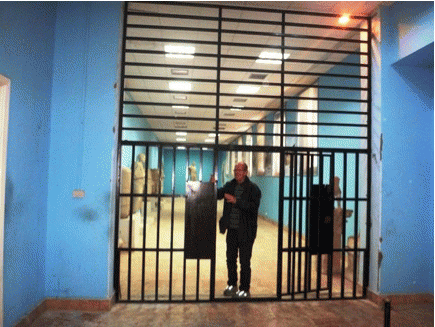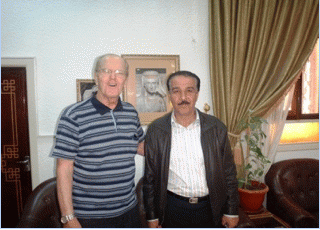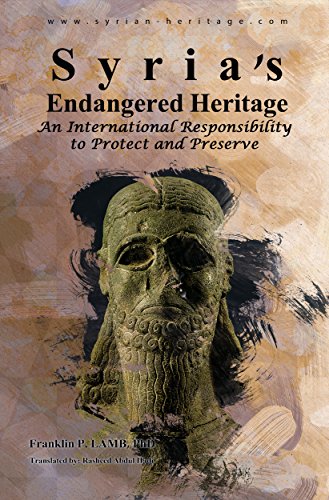Khaled al-Assad was nearly half a century older than Qassem Yehya yet they were from the same band of brothers and sisters in their work and their shared cultural preservation goals. From this observers experience these goals are shared by a large part of Syria's population.
Media attention is currently being given to Khaled al-Assad's murder given its grisly nature and his worldwide reputation earned over five decades of work at his birthplace, Palmyra (Tadmor) in the eastern Syrian desert. Most of us will forever be horrified by the now revealed facts of Khaled al-Assad's murder.
Scholar al-Asaad, who held a diploma in history and education from the University of Damascus, wrote many books and scientific texts either individually or in cooperation with other Syrian or foreign archeologists, SANA said. He also discovered several ancient cemeteries, various caves and the Byzantine cemetery in the garden of the Museum of Palmyra.
His murder has underscored fears that the extremist groups, for whom nothing is sacred, will destroy or loot the 2,000-year-old Roman-era city on the edge of the modern town of the same name, as they have other major archaeological sites in Syria and Iraq. On 8/20/2015 this observer received a credible report from Palmyra that Da'ish (ISIS) militiamen are currently laying explosives among Palmyra's ruins as a sort of 'antiquities shield 'against armed attack from the Syrian army or from the US-led anti-ISIS coalition, the latter now in its second year of targeting the jihadists with checkered results.
During the morning of 8/18/2015 the psychopaths occupying the area since last May, brought Khaled in a van to a main square packed with shoppers. A militant read out five accusations against al-Asaad, including that he was the "director of pagan idols overseeing, hiding and managing Palmyra's collection" that he supported Bashar al-Assad, represented Syria "at infidel conferences" and "visited Iran, the Great Satan."
Immediately another militant unsheathed a knife from his waist and cut scholar al-Assad's throat like a butcher would a chicken, sheep or goat without so much as grimace according to an eye-witness. A board was put and balanced in front of his dangling body and it enumerated the charges against him. The blood drenched body of this scholar and father of six sons and five daughters was then suspended with red twine by its wrists from a traffic light, his head resting on the ground between his feet, his glasses still on, according to a photo distributed on social media by Da'ish supporters.
As a nephew of Mr. Assad explained yesterday from Palmyra via Skype, "After holding and torturing my uncle for three weeks, Da'ish realized that he knew nothing about where the Museum treasures had been hidden or if he did, as they suspected, that my uncle would say nothing." They therefore decapitated the octogenarian.
In May of 2013, Dr. Khalad al- Assad showed this observer and his colleague around the Palmyra National Museum and pointed out, with a sort of pride, the heavy iron gates placed at the front entrance and also several other security measures taken in some of the interior exhibition halls that were designed to protect the collections that were too large to move to safe-houses. I lacked the courage or perhaps the impoliteness to ask this renowned archaeologist if he really thought such precautions were anything more than thinly cosmetic and whether they would really deter anyone from looting the museum-- except perhaps some petty criminals. I have occasionally wondered since that meeting what he thought of the 'impenetrable' iron shields in Palmyra's museum.

Scholar al-Assad was proud of his role in hiding Syrian treasures from would-be looters during the current crisis and of the extensive security system he ordered put into place at the National Museum at Palmyra. Thousands of priceless artifacts are still
(Image by Ayman) Details DMCA
Khaled al-Assad saw the continuity between Syrian Arab culture and that of the many peoples who had previously inhabited Palmyra and he loved both. He even named his first daughter after Zenobia, the queen of Palmyra who challenged Rome's rule 1,700 years ago.

Khalil Hariri, shown above, is the current but absent Palmyra Museum Director. Now reportedly in hiding, he is married to Zenobia, Khaled al-Assad's daughter. Mr. Hariri vows to continue his father-in-laws work preserving our shared cultural heritage.
(Image by Ayman) Details DMCA
A longtime friend and colleague, who prefers to remain anonymous because he is still visits the area, observed "Khalad had a huge repository of knowledge on the site, and that's going to be missed. He knew every nook and cranny. That kind of knowledge is irreplaceable, you can't just buy a book and read it and then have that. There's a certain personal dimension to that knowledge that comes from only having lived that and been so closely involved in it and that's lost to us forever. Now it's lost. We don't have that anymore."
According to a report in the current issue of The Economist, last April just before Da'ish invaded Palmyra, "the archaeologist described on a Facebook page the spring rituals that would have taken place in the colonnaded city during Greco-Roman times. Those rituals "fit perfectly" with pre-Islamic Arab ones, he wrote.
Monitoring the resent activities of Da'ish (ISIS) iconoclasm in Iraq and Syria, this observer increasingly senses that blasphemous idol destruction may be lessening a bit. One perceives that given its budget short-falls, some caused for example by US-led airstrikes against its oil facilities, that the militants are finding looting and trafficking in Syria's antiquities ever more profitable and that Syria's antiquities are more valuable when sold than when obliterated on camera for recruitment and publicity purposes.
(Note: You can view every article as one long page if you sign up as an Advocate Member, or higher).






